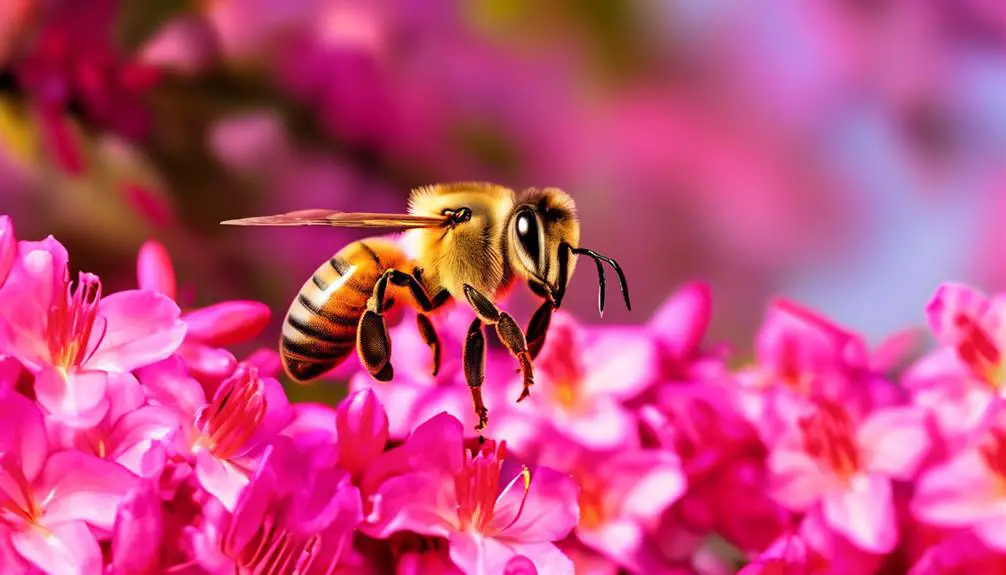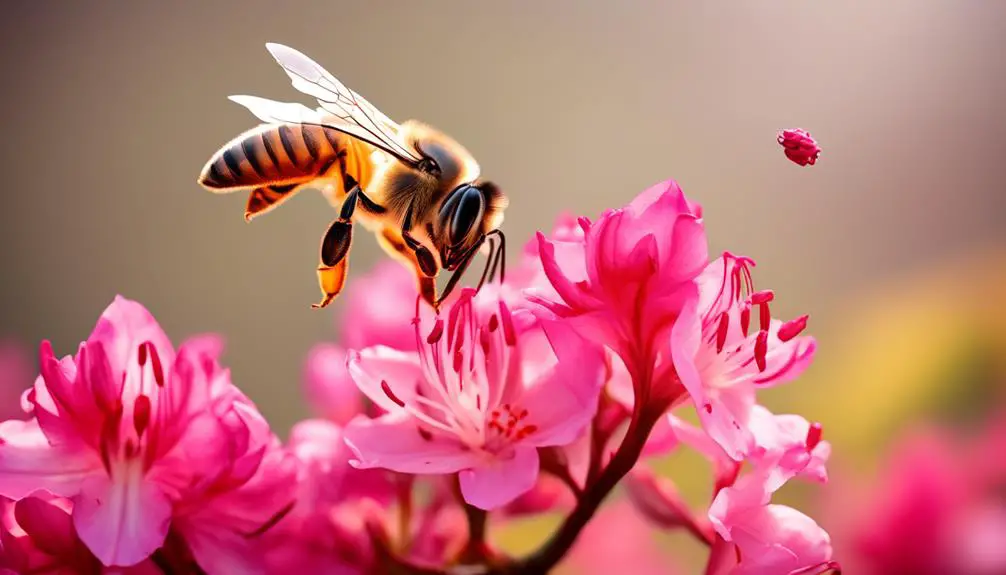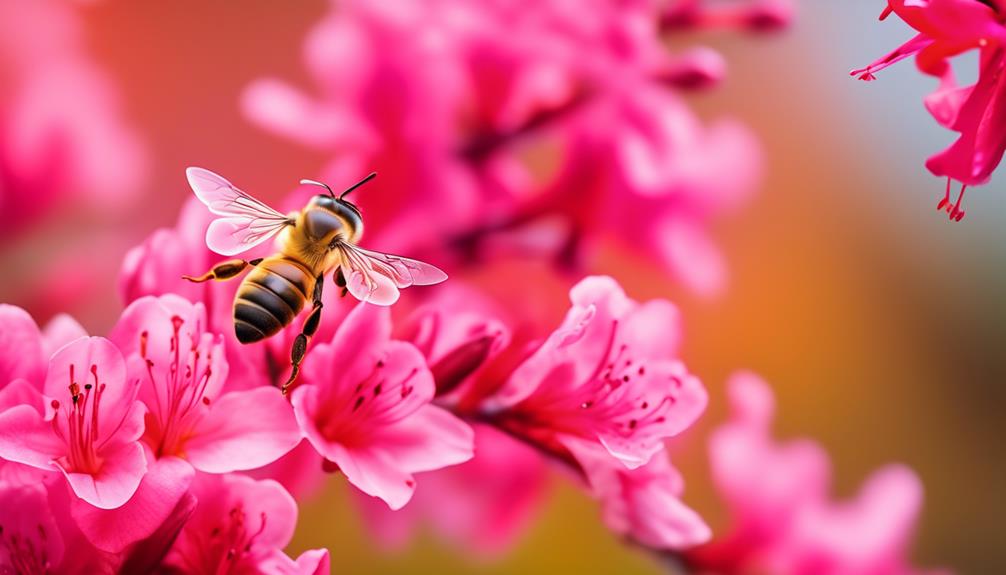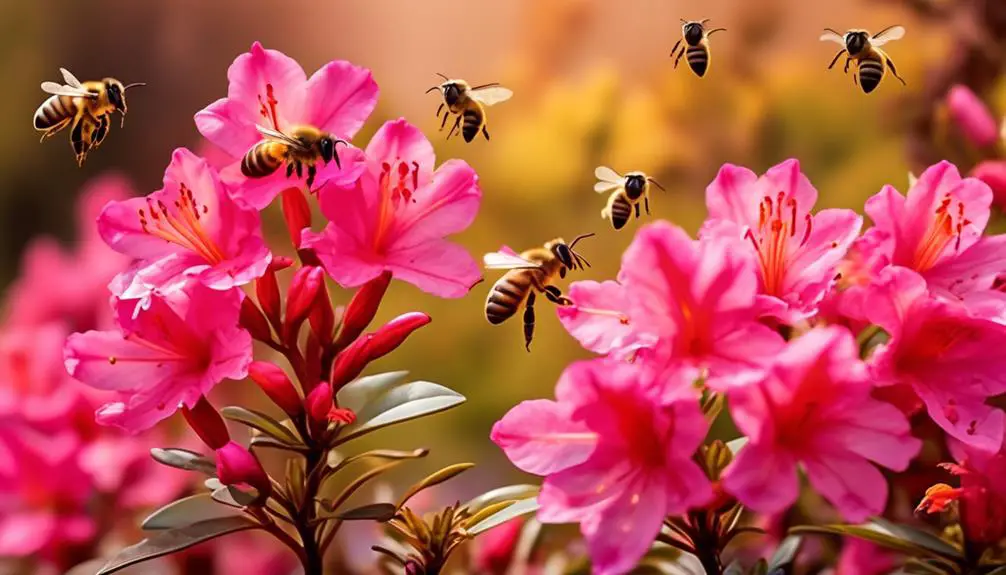Traverse the contentious debate on whether azaleas, with their vibrant allure, might pose a toxic threat to the diligent honey bees.

Are Azaleas Poisonous to Honey Bees
You've likely heard the saying, 'What's sauce for the goose is sauce for the gander,' but when it comes to the relationship between azaleas and honey bees, things aren't quite that simple.
Azaleas, with their vibrant hues and inviting fragrance, are a tempting treat for these industrious pollinators. However, there's a whispering concern among gardeners and beekeepers alike about the potential harm these blooms might cause to our buzzing friends.
So, are azaleas the silent assassins of the bee world, or is this just an unproven myth? Stick around, as we unpack this intriguing topic.
Key Takeaways
- Azaleas contain grayanotoxins that can harm honey bees.
- Some bees have developed resistance to the toxins in azaleas.
- High levels of grayanotoxins can disrupt nerve function in bees and lead to population decline.
- To protect honey bees, limiting the planting of azaleas, planting bee-friendly flora, timing azalea blooming, and using bee-friendly pesticides are important measures.
Understanding Azaleas: A Brief Overview

To fully comprehend the potential toxicity of azaleas to honey bees, it's essential to first understand the basic characteristics of these vibrant flowering shrubs. Azaleas belong to the Rhododendron genus and are known for their strikingly bright colors, typically blossoming in spring. They're native to several continents, including Asia, North America, and Europe, and are thus adaptable to a wide range of climatic conditions.
Diving deeper into their biological makeup, azaleas are deciduous or evergreen, meaning they can either shed their leaves annually or retain them year-round. This factor alone can impact their interaction with honey bees. Typically, the flowers bloom for several weeks, providing a rich source of nectar for bees. However, it's the chemical composition of this nectar that's under scrutiny.
Azaleas contain andromedotoxins, a group of toxins that can be harmful, even fatal, to some organisms. This is where the concern for honey bees arises. Bees are crucial pollinators, and any threat to their survival has widespread ecological and agricultural implications. Therefore, understanding the relationship between azaleas and honey bees requires a deep understanding of the azaleas themselves.
The Honey Bee Diet: A Quick Rundown

Diving into the diet of a honey bee, you'll find it primarily consists of nectar and pollen from a wide variety of flowers, with azaleas potentially playing a significant role in this dietary intake. Nectar, a sweet liquid produced by flowers, serves as a primary energy source for bees, supplying them with necessary carbohydrates. Pollen, on the other hand, provides crucial proteins, fats, vitamins, and minerals.
In a single day, a worker bee might visit up to 100 flowers, collecting nectar and pollen with its specialized body parts. Bees store the nectar in their honey stomach, a separate organ from their digestive stomach, where it undergoes enzymatic processes before being regurgitated as honey. Pollen is packed into 'pollen baskets' on the bee's hind legs and carried back to the hive.
Examining bees' dietary preferences, it's clear they favor flowers with high nectar and pollen content, such as azaleas. But it's essential to consider the potential toxicity of azaleas, which produce grayanotoxins, harmful substances to many organisms. Therefore, understanding the interaction between bees and azaleas could shed light on the health and survival of bee populations.
Azaleas and Honey Bees: The Interaction

In considering the interplay between azaleas and honey bees, it's crucial to take into account the presence of grayanotoxins in azalea nectar and pollen, substances that can potentially be harmful to bees. These toxins, although harmless to the azaleas themselves, can cause a range of negative effects in bees, from slight disorientation to paralysis and even death in extreme cases.
When you observe a bee hovering over an azalea, it's being attracted to the flower's bright colors and the promise of nectar. However, as it collects the nectar and pollen, it's unknowingly ingesting these grayanotoxins. The toxins interfere with the bee's sodium channels, disrupting the normal functioning of its nervous system. This disruption can render the bee unable to fly or even move, making it an easy target for predators.
However, it's important to note that not all honey bees are equally affected. Some bees have developed a certain level of resistance to these toxins, allowing them to continue their pollination activities relatively unscathed. This resistance could be due to genetic factors or the result of gradual adaptation over generations. Still, the interaction between azaleas and honey bees remains a complex and intriguing aspect of nature's workings.
Potential Risks of Azaleas to Honey Bees

While honey bees may seem to thrive amidst the vibrant blooms of azaleas, they're actually exposed to considerable risk due to the plant's grayanotoxin content. This toxin, present in all parts of the azalea plant, can potentially harm these crucial pollinators.
Grayanotoxin Effects on Honey Bees | Details |
|---|---|
Neurological Impact | Grayanotoxin can disrupt nerve function, leading to paralysis or death in bees. |
Population Decline | High toxin levels can cause a significant drop in the bee population, affecting pollination. |
Honey Contamination | Bees bring the toxin back to the hive, contaminating the honey and risking the colony's health. |
It's essential to note, however, that bees' susceptibility to grayanotoxin depends on the azalea species and the bees' tolerance level, which can vary widely. In some cases, bees have evolved to resist the toxin, but in other instances, bees can suffer greatly, even leading to colony collapse. So, while azaleas provide a food source for bees, they also pose a potential risk. You need to weigh the benefits against the dangers when considering planting azaleas in your garden.
Ways to Protect Honey Bees From Azaleas

Given the potential risks azaleas pose to honey bees, it's crucial to explore effective methods to safeguard these important pollinators from the plant's harmful grayanotoxin.
Firstly, you can limit the planting of azaleas in your garden, particularly if beekeeping is your primary interest. By reducing the bees' exposure to azaleas, you decrease the likelihood of them ingesting harmful toxins.
Another strategy is to plant bee-friendly flora alongside azaleas. Plants such as lavender, sunflowers, and marjoram aren't just attractive to bees, but they also provide a safe nectar source. By diversifying your garden, you're offering bees an alternative to azaleas, hence reducing their exposure to grayanotoxin.
Thirdly, consider the timing of azalea blooming. Since azaleas typically bloom in spring, ensure that you have other plants blooming during that season. This way, bees are less likely to focus on azaleas.
Lastly, consider using bee-friendly pesticides in your garden. Many pesticides can exacerbate the effects of grayanotoxin, thus further endangering the bees. By opting for safer alternatives, you can protect your bees from double jeopardy.
Conclusion
Azaleas, while beautiful, can pose a risk to honey bees due to their naturally occurring toxins. As a beekeeper, it's vital to understand this interaction and take steps to limit bees' exposure.
By carefully managing the proximity of azaleas to hives and monitoring the bees' health, you're playing your part in preserving these vital pollinators.
Remember, their welfare is crucial not just for honey production, but for overall biodiversity and environmental health.



